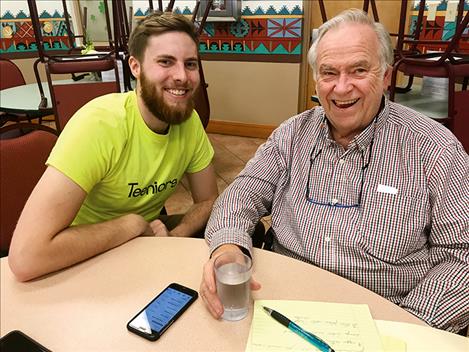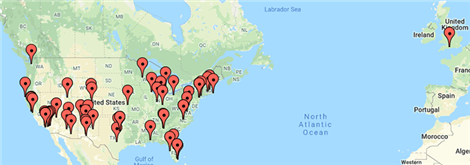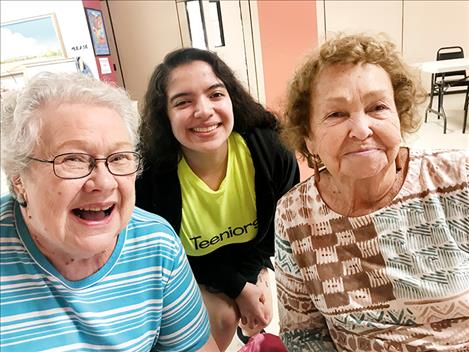Making the connection
What technology, adults and teens have in common
Hey savvy news reader! Thanks for choosing local.
You are now reading
1 of 3 free articles.
Montana is the oldest state west of the Mississippi, and demographic projections show the state growing collectively older as more Montanans enter their senior years. The economic,
cultural, and personal impacts of that trend present the state and its residents with new challenges and, with those challenges, opportunities.
Graying Pains is a series of weekly stories and broadcasts exploring those challenges and opportunities in communities statewide. By investigating how other communities have responded to the issues raised by aging, Graying Pains hopes to point the way toward policies and innovations that can help Montana, and Montanans, improve with age.
The series is produced by the Montana Fourth Estate Project, a collaboration among 13 Montana newsrooms and the University of Montana School of Journalism coordinated by Montana Free Press under the auspices of the Montana Newspaper Association and the Solutions Journalism Network. See montanafourthestate.org for the collected Graying Pains stories and more information.
______________________________________
Anyone can understand that tech support in the form of automated chats or lengthy phone calls can lead to more stress than solutions. “Do we really need anymore apps in the world right now?” Trish Lopez asked herself as she listened to other people pitch at a startup incubator in Albuquerque, New Mexico, in 2015.
Lopez’s own contribution to the incubator stemmed from her mother’s love and hatred of technology — she understood its benefits but would grow frustrated with the learning curve. Lopez’s experience at New Mexico’s Startup Weekend: Women’s Edition evolved into a pitch to connect teens with older adults to provide technology help. Lopez founded Teeniors as a result, which uses intergenerational connection to provide personal technology support and offers programs to support seniors who can pay and those who cannot. There are currently 14 teens in the program who are referred to as Teeniors.
Oceana Wadhams saw a flyer advertising a Teeniors job and thought it would be a perfect fit. She grew up living with her great-grandparents and felt like working with older adults “called to me.” Barbara, her first client, needed help with her iPhone. The experience of helping her “always stood out to me because she was so thankful,” Wadhams said.
Teeniors, based in Albuquerque, was five years old before the coronavirus forced operations to change. Lopez asked teens if they were comfortable supporting seniors via video or phone call. The decision to go forward with a remote structure was unanimous, and funding from grants made the transition possible.
“I think all of [the Teeniors] were ambivalent about how this would work, and I was too,” Lopez said. “Is this going to be as good as in-person coaching? No. But are we going to do our best to make it the best experience of virtual coaching possible? Yes.”
Judith Binder has been a Teeniors client before and during COVID-19. She discovered Teeniors at a monthly potluck put on by county commissioners in Albuquerque. Despite having worked in a university computer science department in the 1980s, she found value in the service. “They didn’t rush me. And I’m sure that’s part of their skill. They waited until I was able to really grasp the concepts that they were showing me,” Binder said.
Pivoting to remote instruction allowed Teeniors to reach older adults beyond Albuquerque and New Mexico. Lopez estimated 100 virtual coaching sessions took place during April and May, and 15 percent of the calls have come from out-of-state.
“We were able to pivot in a way I was comfortable with because our kids wanted to work, and certainly our seniors wanted to stay connected to friends and family, and all of us wanted to decrease social isolation,” Lopez said. She noted that remote sessions will continue to be an option even as it becomes possible to offer in-person services.
Lopez was not surprised by the challenges: finding teleconferencing software that doesn’t require an account and worrying about Zoom scams. What surprised her was how much Teeniors gained in the transition. “I look forward to the days when we can help people in-person again because I think there’s really something to that intergenerational connection in-person,” she said. “But right now, the Teeniors are happy with how things are going.”
Teeniors’ new clients in the coronavirus era are diverse in age and ability. A high school and a college teacher wanted to get a grip on Zoom before hosting their first classes. David Larson [the reporter’s father], 62, not a Teeniors client but an engineer with the Montana Department of Natural Resources and Conservation, said he can relate to the need.
“It was one of these things where I was supposed to learn all this technology,” he said. Working from home meant learning how to navigate Zoom, Microsoft Teams and a remote work setting. Larson said it might have been easier to adapt if he was younger, but “I’m just an old guy,” he said.
“I don’t even think it’s easier when you’re 16 to learn [technology],” Lopez said. “I think that there’s no social shame about not knowing,”
Binder praised Teeniors’ ability to communicate effectively and complimented their respect and patience. From her perspective, some of the shame of not knowing can be alleviated by proper communication.
Ninety percent of Teeniors said they had benefited personally, and all reported feeling more economically stable, better equipped to enter the workforce or apply to college, and all shared that being a Teenior improved their communication with older adults. “I think it’s important that we get clear on what the people need before we rush in to help. I think that’s the biggest mistake that people tend to make in general,” Lopez said.
The Big Sky Community Organization and Big Sky Relief joined to brainstorm about what assistance older adults may need as the coronavirus entered Montana. Senior Buddies, a program resulting from that conversation, has a similar model to Teeniors, but without the technology focus. A younger person is paired with an older adult to pick up mail and get groceries. Sixty-five community members volunteered and eight people requested assistance through the program.
“[Technology support] was something we really discussed in the beginning, and we were having a hard time reaching out to that demographic in order to provide that service,” said Mackenzie Johnson, program organizer for BSCO. The group had the volunteer power, but the adults Johnson spoke with got their technology help from family members or friends. The need, when she reached out, was not there.
Before Teeniors began, Lopez surveyed senior centers in New Mexico to find out whether technology help was needed and if seniors wanted teens to provide that help. Now, Teeniors employs young people with meaningful jobs, has created a nonprofit arm to support seniors who cannot afford to pay and, through the evolution to online support, reaches seniors and others outside New Mexico.
In the past months, many people have rediscovered the human need for connection, and Teeniors has found that assisting older adults with technology can help build those connections, bridging generational divides and helping those on both sides to better connect with each other.
“I really believe that ageism is the last acceptable prejudice,” Lopez said. She is confident the young adults she employs as Teeniors are prepared to change that.


















